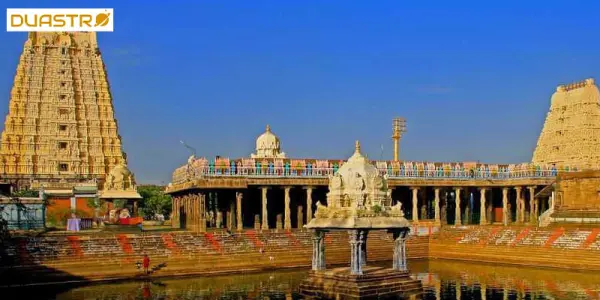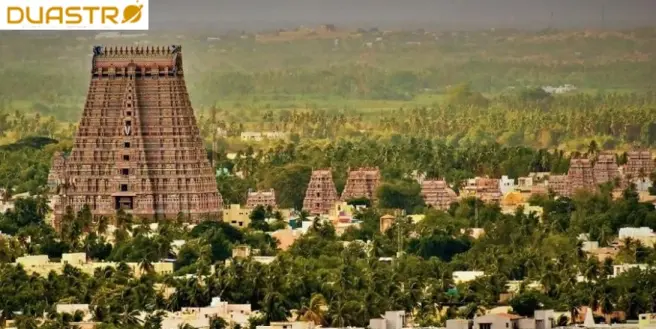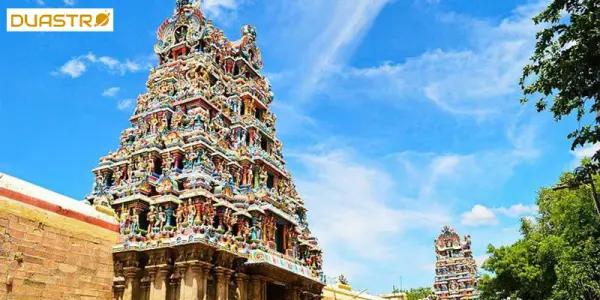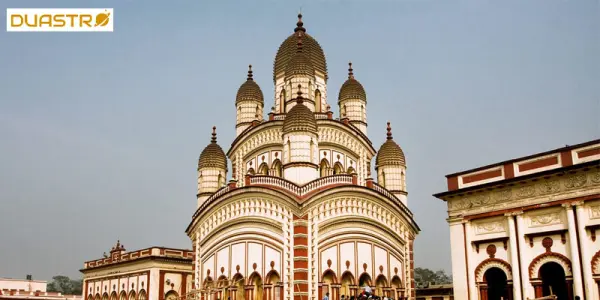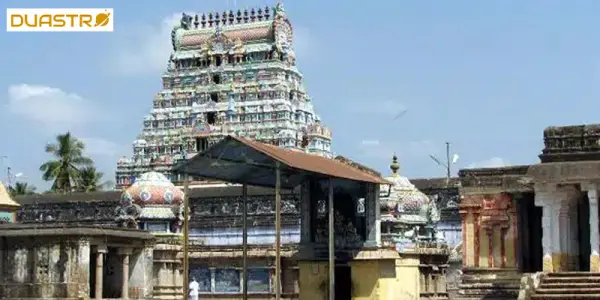Introduction to Ekambareswarar Temple
Nestled in the sacred town of Kanchipuram the Ekambareswarar Temple stands as a magnificent testament to centuries of devotion & architectural brilliance. Dedicated to Lord Shiva revered here as Ekambareswarar meaning Lord of the Mango Tree this temple reflects the good blend of spirituality & artistry that defines Hindu sacred spaces. The temple origins trace back to the Sangam era & later dynasties such as the Pallavas Cholas & Vijayanagara rulers contributed grandly to its structure. Pilgrims journey here to witness the towering gopurams complex carvings & to seek blessings for harmony prosperity & spiritual growth. In this article guided by the seasoned wisdom of Pandit Amit Patel an expert with over two decades of experience in temple astrology & cultural tradition we explore the rich tapestry of history spiritual benefits ritual practices important dates dos & donts & address common questions devotees encounter. His deep understanding of temple dynamics enriches every understand shared here.
Benefits of Visiting & Worshiping at Ekambareswarar Temple
A pilgrimage to the Ekambareswarar Temple offers not just a sacred journey but a game-changing experience for mind body & spirit. Devotees often report a deep sense of calm & inner alignment after participating in the rituals & circumambulations. As a powerful center of Lord Shiva energy the temple fosters spiritual growth emotional healing & clarity of purpose. The temple is primary famous for granting marital harmony fertility & familial prosperity. Couples seeking blessings for a happy union are drawn to the divine interplay of Shiva & Parvati within the sanctum believing in its power to strengthen love bonds. Health improvements & relief from chronic ailments are also attributed to sincere worship here primary when performed on better days. For those exploring overall wellbeing combining temple blessings with a personalised health horoscope consultation can further align mind body & divine grace. Overall the blessings of Ekambareswarar are believed to permeate every facet of life offering protection prosperity & a renewed sense of devotion.
Types or Variations of Rituals & Aspects
The spiritual tapestry of Ekambareswarar Temple includes a rich variety of rituals personalised for specific intentions & energies. The daily puja rituals—morning abhishekam midday offerings & evening illumination—honor Lord Shiva with reverence & routine. For devotees seeking deeper spiritual empowerment special pujas like the Maha Shivaratri abhishekam 108 bilva leaf offering & Rudrabhishekam hold great significance. During festivals such as Mahashivaratri Navaratri & the annual Panguni Uthiram the temple pulses with vibrant celebrations sacred chants & cultural performances. Another unique aspect is the consecration beneath the giant mango tree believed to be over 3500 years old symbolizing deep-rooted connection with nature & divine energy. There are also variations in ritual approach depending on one purpose—whether seeking marital harmony germination of new business ideas or spiritual advancement. For couples a specialized puja may be performed to invoke the divine presence of Shiva & Parvati. Families seeking prosperity can choose rituals timed to Navagraha alignments. Visitors can explore personal needs more deeply through a married life horoscope review or consultation to select the most supportive ritual for their journey.
How & When to Worship at Ekambareswarar Temple
Planning a visit to Ekambareswarar Temple with intention & timing makes the experience profoundly meaningful. The temple is open daily from early morning until evening & timing your worship during key periods such as sunrise or sunset amplifies spiritual benefits. Each day of the week perfectly go with particular planetary energies—Monday resonates with Shiva energy & is primary sacred here. Devotees seeking emotional calm & spiritual alignment may find Monday worship particularly effective. For marital & fertility blessings Thursdays & Fridays are considered better. The nine-night festival of Navaratri & the full moon of Panguni Uthiram are the most celebrated events here & participating in rituals during these days can bring exceptional blessings. For practical planning pilgrims may choose a foreign travel astrology report to pick an better travel window primary if coming from abroad. Rituals are best conducted with purity—taking a spiritual bath before entering dressing modestly & focusing the mind through mantra or introspection. Remember that personal intent & faith are the true catalysts that activate the temple vibrations.
Remedies Dos & Donts for Devotees
Observing simple yet powerful guidelines can greatly increase the efficacy of your visit to Ekambareswarar Temple. Devotees are encouraged to maintain inner & outer purity—avoiding negative thoughts speaking kindly & wearing clean modest clothes. Bring offerings such as bilva leaves incense sticks camphor & fresh fruits as these items align with Shiva blessings. Standing beneath the ancient mango tree to meditate or pray acknowledges the sacred tradition of the temple & invokes primal energy. Avoid entering the sanctum with footwear non-vegetarian food or intoxicated state as these actions diminish spiritual receptivity. This is also recommended to avoid paying temple fees with harsh words or hasty actions. If you face obstacles in personal life or health performing Rudrabhishekam chanting the Maha Mrityunjaya mantra or participating in a public abhishekam can be primary healing. For serious challenges consulting a kundli dosha analysis helps determine underlying planetary imbalances & supports targeted remedies. In the end following these dos & avoiding transgressions helps maintain the sanctity of your visit & amplifies the grace you receive from Ekambareswarar.
Important Dates & Celebrations
Several dates throughout the year carry special significance at Ekambareswarar Temple & participating on these days amplifies spiritual benefit. The annual Panguni Uthiram festival occurring in the Tamil month of Panguni (March–April) celebrates the divine marriage of Shiva & Parvati & is marked by grand processions & chants. Mahashivaratri usually in February or March is observed with night-long vigils Rudrabhishekam & devotional singing offering devotees a chance for deep spiritual awakening. Navaratri in September–October & the new moon monthly abhishekam are other better occasions to visit. Mondays throughout the year particularly full moon Mondays & Pradosha days are ideal for sincere prayer & abhishekam. For those planning a special pilgrimage arranging temple darshan & rituals close to one of these dates is beneficial. Visitors can coordinate their trip with astrological guidance from a 12-month family horoscope report to ensure their temple visit perfectly go with positive cosmic energy.
FAQ About Ekambareswarar Temple
What is the best time to visit Ekambareswarar Temple?
Early mornings & evenings are considered the most better times to visit. Mondays & full moon days carry added spiritual significance as do festival dates like Mahashivaratri & Panguni Uthiram.
Can non-Hindus visit the temple?
Yes. All are welcome to enter the temple premises observe the architecture & offer prayers. Strict dress code & cleanliness requirements apply to maintain sanctity.
Are there any restrictions or dress code?
Devotees must dress modestly remove footwear before entering inner sanctum & avoid non-vegetarian food or alcohol. Purity of mind & body is essential.
Is it necessary to perform special poojas?
While daily pujas are conducted by temple priests devotees may choose for additional rituals like Rudrabhishekam or bilva leaf offerings for personal intentions which can be booked at the temple office.
How can I benefit spiritually from this visit?
Combine sincerity of heart with ritual purity & appropriate timing. Chanting meditation under the mango tree & offering traditional items help align your energy with the divine presence.
Conclusion & Encouragement
The Ekambareswarar Temple offers a timeless journey into devotion tradition & divine communion. By wide its history partaking in its rituals with reverence & aligning your visit with important dates you open a powerful channel of spiritual benefit. Remember that your personal sincerity & heartfelt prayers are the true first brick of this pilgrimage. Whether seeking inner peace family harmony or life transformation this sacred space has the capacity to uplift & guide your path. Plan your visit thoughtfully honor the dos & donts & immerse yourself in the temple vibrations. Your journey does not end at the temple gate—it extends into your daily life through devotion clarity & grace. To deepen your experience consider consulting a personalised astrology service to align your spiritual travel & rituals with your natal chart.
About the Expert: Pandit Amit Patel
This detailed guide is authored by Pandit Amit Patel a respected temple astrologer & scholar with more than twenty years of experience researching Vedic traditions & sacred spaces across South India. Specialising in temple rituals pilgrimage astrology & kundli dosha remedies he has guided thousands of devotees toward meaningful experiences at temples. His knowledge of Ekambareswarar Temple lore combined with practical ritual wisdom provides readers with understands that are both spiritual & practical. With heartfelt clarity Pandit Patel continues to shed light on sacred pathways for seekers on Duastro.

